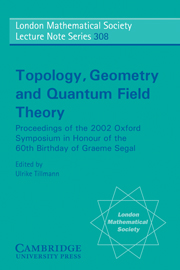 Topology, Geometry and Quantum Field Theory
Topology, Geometry and Quantum Field Theory Book contents
- Frontmatter
- Contents
- Preface
- Participants
- Introduction
- Part I Contributions
- 1 A variant of K-theory: K±
- 2 Two-vector bundles and forms of elliptic cohomology
- 3 Geometric realization of the Segal–Sugawara construction
- 4 Differential isomorphism and equivalence of algebraic varieties
- 5 A polarized view of string topology
- 6 Random matrices and Calabi–Yau geometry
- 7 A survey of the topological properties of symplectomorphism groups
- 8 K-theory from a physical perspective
- 9 Heisenberg groups and algebraic topology
- 10 What is an elliptic object?
- 11 Open and closed string field theory interpreted in classical algebraic topology
- 12 K-theory of the moduli space of bundles on a surface and deformations of the Verlinde algebra
- 13 Cohomology of the stable mapping class group
- 14 Conformal field theory in four and six dimensions
- Part II The definition of conformal field theory
- Foreword and postscript
- The definition of CFT
- References
1 - A variant of K-theory: K±
Published online by Cambridge University Press: 06 November 2009
- Frontmatter
- Contents
- Preface
- Participants
- Introduction
- Part I Contributions
- 1 A variant of K-theory: K±
- 2 Two-vector bundles and forms of elliptic cohomology
- 3 Geometric realization of the Segal–Sugawara construction
- 4 Differential isomorphism and equivalence of algebraic varieties
- 5 A polarized view of string topology
- 6 Random matrices and Calabi–Yau geometry
- 7 A survey of the topological properties of symplectomorphism groups
- 8 K-theory from a physical perspective
- 9 Heisenberg groups and algebraic topology
- 10 What is an elliptic object?
- 11 Open and closed string field theory interpreted in classical algebraic topology
- 12 K-theory of the moduli space of bundles on a surface and deformations of the Verlinde algebra
- 13 Cohomology of the stable mapping class group
- 14 Conformal field theory in four and six dimensions
- Part II The definition of conformal field theory
- Foreword and postscript
- The definition of CFT
- References
Summary
Introduction
Topological K-theory has many variants which have been developed and exploited for geometric purposes. There are real or quaternionic versions, ‘Real’ K-theory in the sense of, equivariant K-theory and combinations of all these.
In recent years K-theory has found unexpected application in the physics of string theories and all variants of K-theory that had previously been developed appear to be needed. There are even variants, needed for the physics, which had previously escaped attention, and it is one such variant that is the subject of this paper.
This variant, denoted by K±(X), was introduced by Witten in relation to ‘orientifolds’. The geometric situation concerns a manifold X with an involution τ having a fixed sub-manifold Y. On X one wants to study a pair of complex vector bundles (E+, E–) with the property that τ interchanges them. If we think of the virtual vector bundle E+ – E–, then τ takes this into its negative, and K±(X) is meant to be the appropriate K-theory of this situation.
In physics, X is a 10-dimensional Lorentzian manifold and maps ∑ → X of a surface ∑ describe the world-sheet of strings. The symmetry requirements for the appropriate Feynman integral impose conditions that the putative K-theory K±(X) has to satisfy.
The second author proposed a precise topological definition of K±(X) which appears to meet the physics requirements, but it was not entirely clear how to link the physics with the geometry.
- Type
- Chapter
- Information
- Topology, Geometry and Quantum Field TheoryProceedings of the 2002 Oxford Symposium in Honour of the 60th Birthday of Graeme Segal, pp. 5 - 17Publisher: Cambridge University PressPrint publication year: 2004
- 4
- Cited by


